what type of graphics card to play assasins creed origins on ultra high settings
Assassin'due south Creed Origins is one of the nearly enervating games around
Assassin'south Creed Origins is one of the strongest entries in the long-running series. Taking a yr'due south suspension paid off, and Egypt comes to life in a game that'southward often visually stunning. But in that location's a dark side to the brotherhood—well, another dark side—and information technology's that the game has some steep hardware requirements.
Ubisoft lists a GTX 660 or R9 270 graphics card equally its minimum hardware requirements, with an i5-2400s or FX-6350 CPU. That doesn't sound too bad, but information technology'south of import to notation that Ubisoft is talking about thirty fps at 720p minimum quality settings, not 60 fps at 1080p. The recommended hardware meanwhile is a GTX 760 or R9 280X, with an i7-3770 or FX-8350, simply again that's only probable to get you 30 fps at 1080p high settings.
In my testing, for 1080p medium at 30 fps you'll need at to the lowest degree a GTX 1050—which equates to a GTX 960, GTX 770, or GTX 680. The GTX 760 is a fairly sizeable xv-25 pct step down from the 770 (which I've tested below), so 1080p high seems an unlikely target. On the AMD side, you'll need an RX 560 or R9 380 for 1080p medium, and the R9 280X is going to exist around that aforementioned level of performance. 1080p high should be doable, but only at thirty fps.
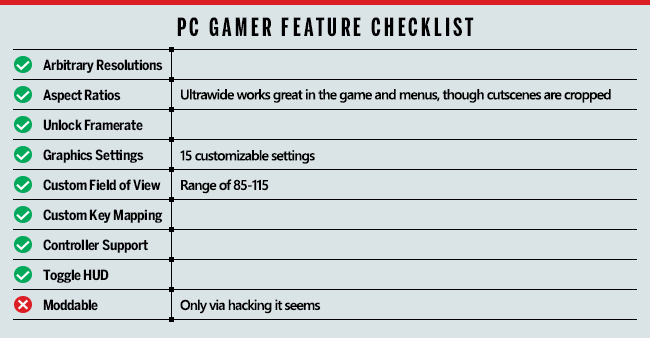
A word on our sponsor

As our partner for these detailed operation analyses, MSI provided the hardware we needed to examination Assassin's Creed Origins on a bunch of unlike AMD and Nvidia GPUs and laptops—see below for the full details. Full details of our examination equipment and methodology are detailed in our Performance Analysis 101 commodity. Thanks, MSI!
As far as features go, Assassin'due south Creed Origins does nearly everything right, with the exception of mod support. That's keeping with Ubisoft tradition, which is unfortunate every bit we'd love to meet the modding community tweak some aspects of the game. There accept been texture updates for some of the previous games, only not much more that. Ultrawide support is nearly perfect, except for in the small number of cutscenes. These show black bars on the right and left, just the menus and game world all look stunning on 21:9 displays.
The graphics settings seem like a fairly comprehensive list, and I'll dig into the individual settings and their functioning impact at the end of the article. The only problem is that most of the settings only cause a small alter in performance. On modern GPUs like the GTX 1060 and higher up, or the RX 570 and above, going from ultra loftier quality to very low quality only improves performance past about 50 pct. Cards with less than 4GB VRAM may testify greater improvements in performance, simply it still requires a fast GPU if you want to get in a higher place 60 fps.
MSI provided all the hardware for my testing with its Gaming X graphics cards for virtually of the models. The Vega 56 and 64 are reference designs, all the same, equally MSI has non notwithstanding announced or released whatsoever custom solutions. While I've previously used MSI'due south Aegis Ti3 as the chief test platform, it turns out that an i7-7700K can actually limit performance on the faster GPUs, so I've moved to MSI's Z370 Gaming Pro Carbon AC (opens in new tab) with a Cadre i7-8700K (opens in new tab) as the weapon of choice, with 16GB of DDR4-3200 CL14 retentivity from G.Skill (opens in new tab). I also had some issues getting Origins to run on several of the MSI notebooks, then I've included the GT73VR results in the principal charts.
So what does it actually take to run the game well? You'll demand both a fast CPU and a fast graphics carte du jour to get the most out of Assassin'southward Creed Origins on PC, and Nvidia GPUs currently prove substantially better performance than AMD'south GPUs.
Ubisoft says it hasn't used any Nvidia GameWorks libraries this time, and told us, "We have been working very closely with both AMD and NVIDIA for quite a while (and continue to do so) to allow usa maximize performance on both GPUs. We are committed to taking advantage of any operation gains available with the new drivers to assistance players have the best experience they tin can in ACO with the hardware they have. You can wait we will take the opportunity to make whatsoever tweaks which lead to functioning gains in the upcoming updates."

All of my electric current testing was done with the 1.03 patch, using Nvidia's latest 388.13 drivers and AMD'due south 17.xi.1 drivers—which is an update from the initial testing I did at the time of launch. The i.03 patch smoothed out some of the minimum fps problems, and Nvidia operation across nearly all GPUs improved substantially. AMD performance meanwhile remained flat, with some minor drops in some cases. Hopefully future patches and/or driver updates will assist Radeon owners out.
AC Origins includes a built-in benchmark, under the graphics carte, which is what I used for testing. I also did a manual operation run through the starting city of Siwa, including sword fights, assassinations, and riding around on a horse, and found that the born benchmark gives a reasonable comparison point. Variation between runs is lower, and information technology's within a few percent of the operation I measured while playing the game normally. If yous wander off into the desert, performance—particularly on AMD cards—is higher, but much of the game volition be spent in the cities, which are more taxing.
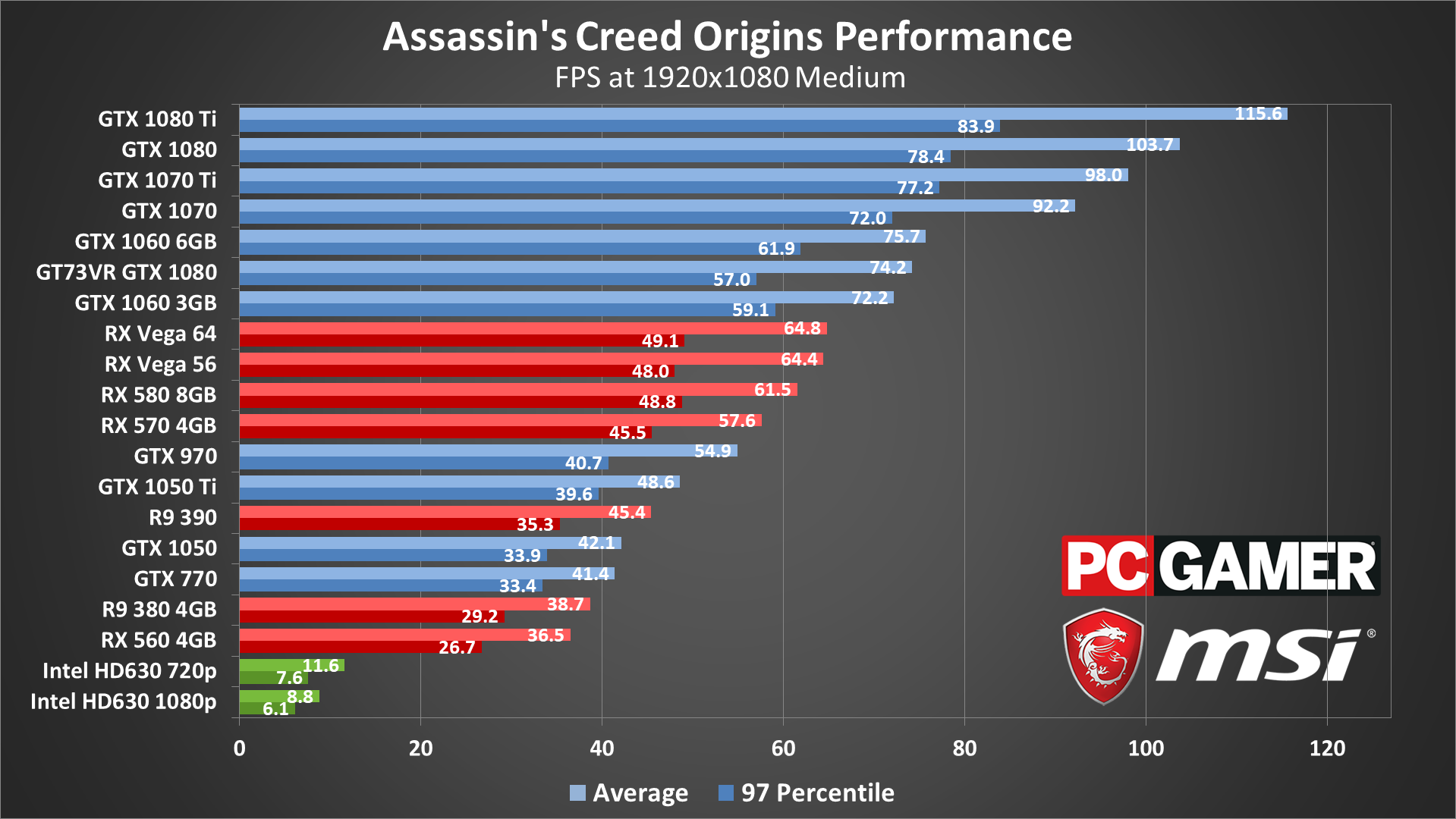
Starting at 1080p medium, which represents a decent compromise between performance and prototype quality, AMD users should immediately encounter red flags. The fastest AMD GPUs max out at less than threescore fps, while Nvidia GPUs can break into the 100+ fps range. More critically, even the GTX 1060 3GB is able to shell the Vega 64.
I've done extensive testing of AC Origins, on multiple CPUs and motherboards, and these results are very consistent. Unless you lot want to benchmark the game exterior of the cities, AMD GPUs come up seriously short. AMD GPU utilization was often in the 60-lxxx pct range, indicating other bottlenecks besides the GPU core are limiting functioning. It could be geometry throughput, but even using the very depression preset (which disables tessellation and sets all the other options to minimum) the RX Vega 64 just scored 71 fps at 1080p. At that place's obviously more work to exercise to get AC Origins running well on AMD hardware, and Nvidia easily wins any comparisons you might make at these settings.
Information technology's not only AMD hardware struggling with the game, every bit Intel'due south HD Graphics 630 (running on an i7-7700K) couldn't even get above xx fps at 720p minimum quality. You'll need a decent GPU to run Origins.
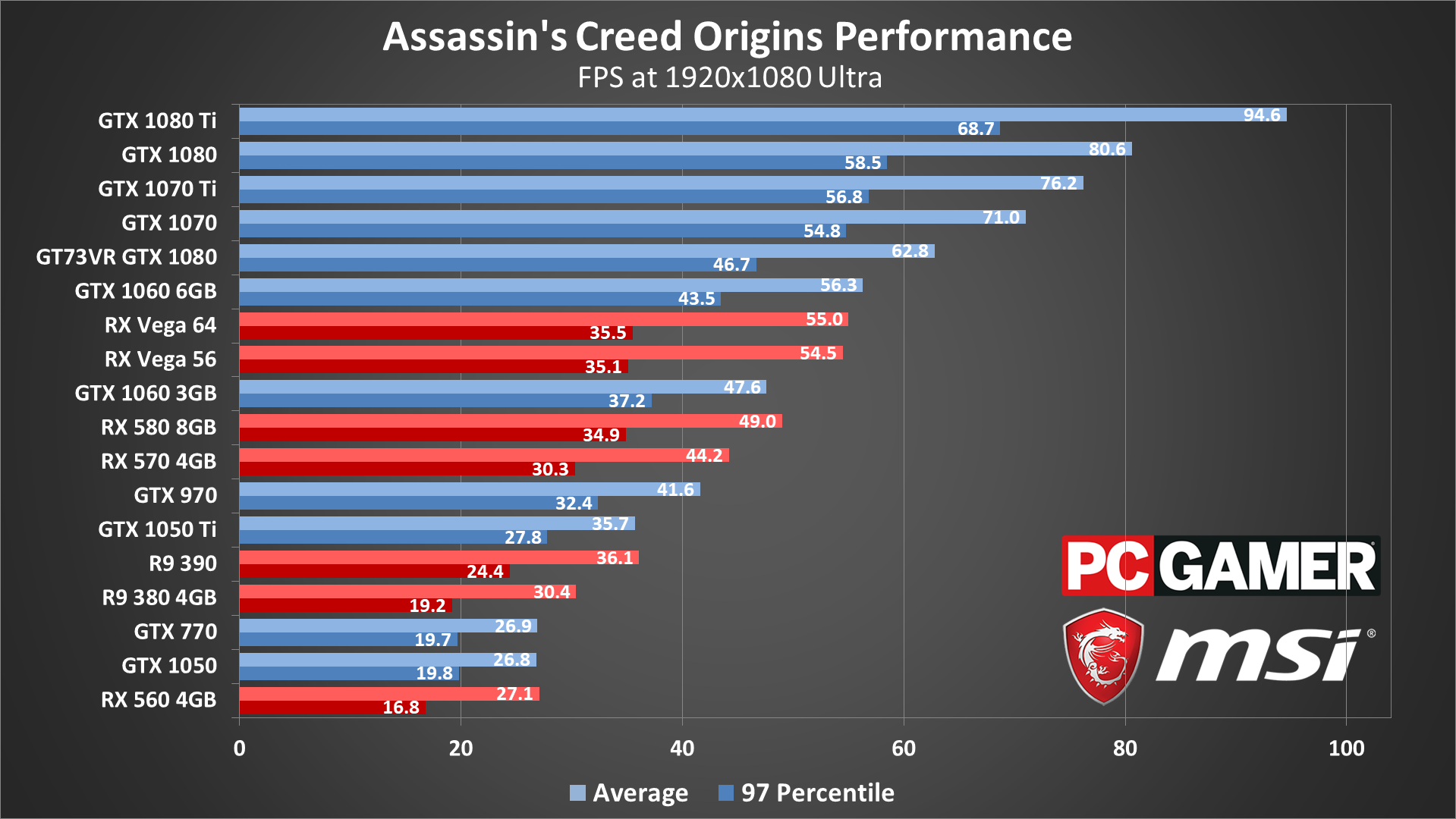
Moving upwards to 1080p ultra, Nvidia continues to boss, with the 1060 6GB beating every AMD GPU. The game settings menu estimates VRAM utilise of almost 2.8GB using these settings, so the 1060 3GB still manages to perform well plenty, but for very high and ultra quality you'll likely want a 4GB GPU. I'll discuss the settings more in a moment, merely Air-conditioning Origins can definitely button your GPU to its limits.
Equally before, GPU utilization on AMD cards isn't above xc percent on the faster models, indicating other bottlenecks. The Vega cards do fine in less populated areas, only as soon as you enter a city, framerates tin can drop by 50 percentage or more. If y'all're looking for 60 fps or higher at 1080p ultra, but the GTX 1070 and above accomplish that feat, though the GTX 1060 and Vega cards can go at that place at 1080p high settings.
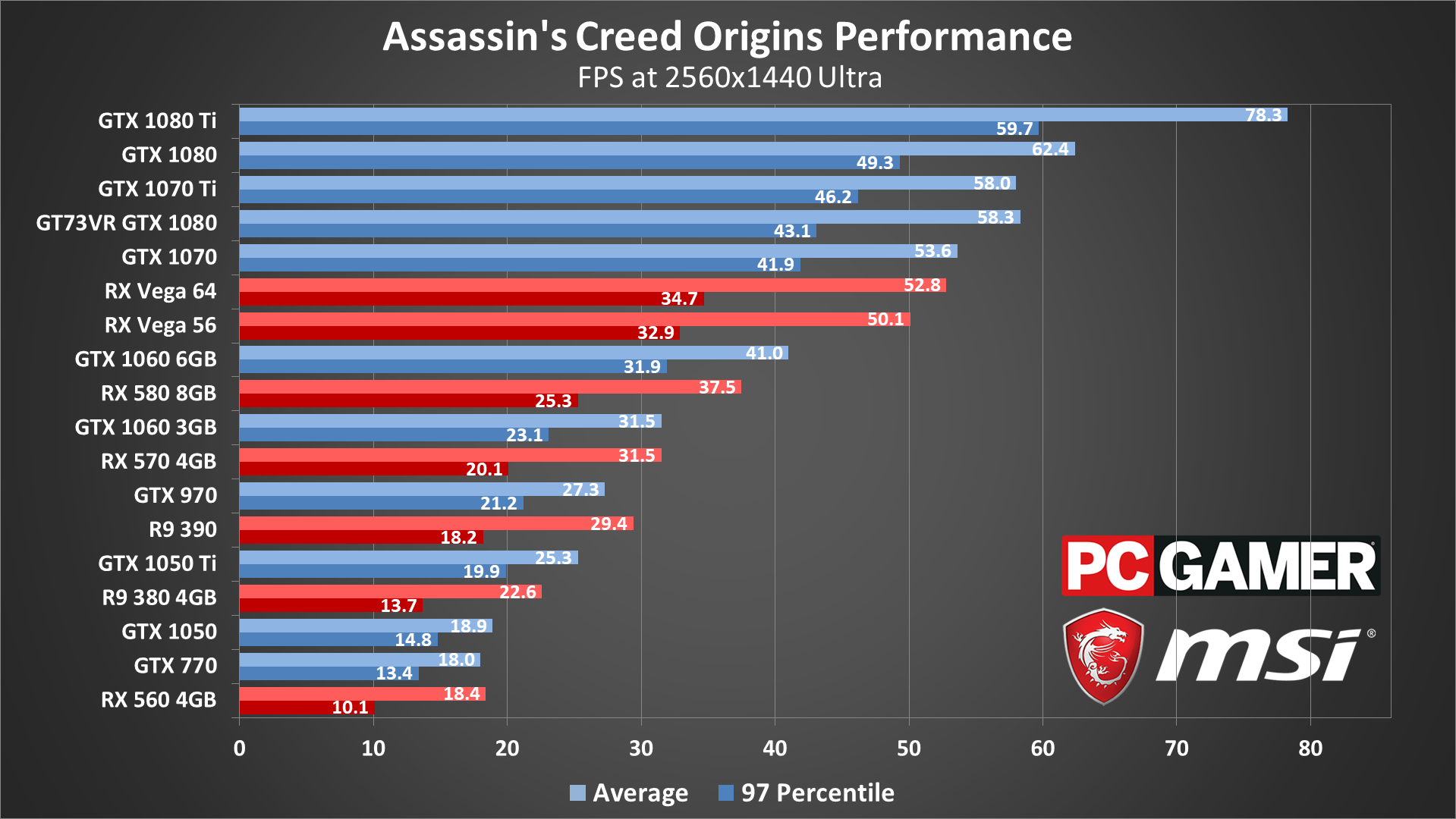
1440p requires some serious hardware if you want to come up close to threescore fps—and yes, in that location's a very articulate difference in feel between thirty and lx fps in Air-conditioning Origins. But the GTX 1080 and 1080 Ti get there, though overclocking the 1070 Ti and mayhap the 1070 (with a few tweaks to settings) should suffice too.
Vega can also pause 60 fps with the correct settings, merely there'southward a lot more microstuttering (dips below the average framerate) on AMD cards. AMD'southward Vega cards kickoff to proceeds on Nvidia at 1440p, and GPU utilization also increases. Basically, drivers and CPU go less of a limiting factor as resolution increases.
If you're sporting multiple graphics cards, you lot're unfortunately out of luck—Origins won't utilize currently more than a unmarried GPU. Considering the CPU limits imposed by the engine, that's probably for the all-time, and this is one more than major release in a growing list where SLI and CrossFire won't practice y'all any good. That may change in the future, just I wouldn't count on information technology.

Not surprisingly, 4k ultra is by and large out of accomplish for now. If yous want to get 60 fps at 4k, your only real choice is going to be 1080 Ti, and then use a combination of medium and high settings. Even the GTX 1080 at minimum quality just averages in the mid-50s at 4k—and yes, information technology will get higher in less demanding areas of the game, just on the whole you'll meet enough of drops beneath lx.
4k is also the only identify where the Vega cards tin outset to match Nvidia's 1070 and 1070 Ti. Minimum framerates withal favor Nvidia hardware, but it shows that when the GPU cores are the major limitation, AMD'southward hardware holds up pretty well. Either the drivers or the game engine are property the cards back at lower resolutions and settings.
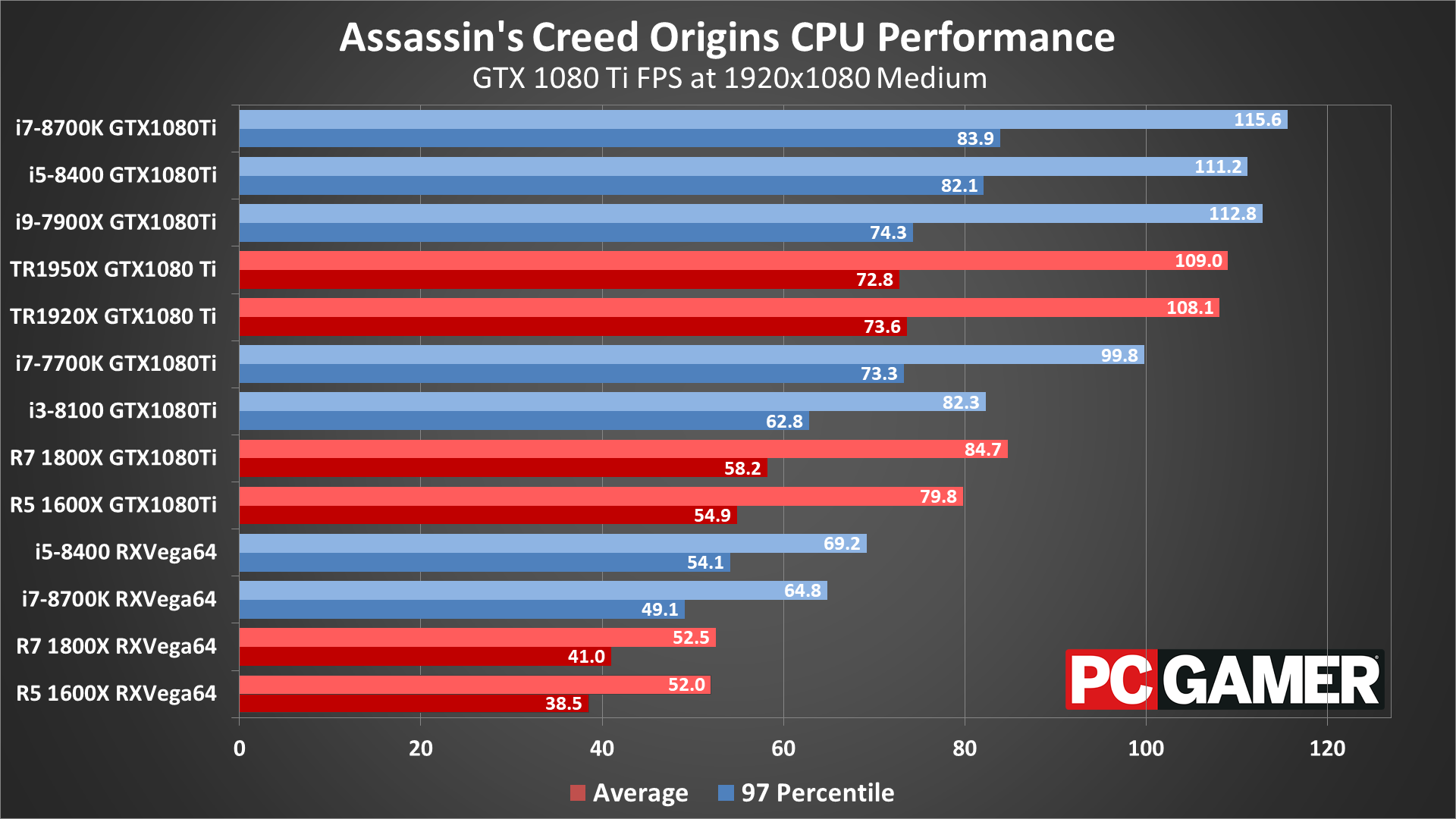
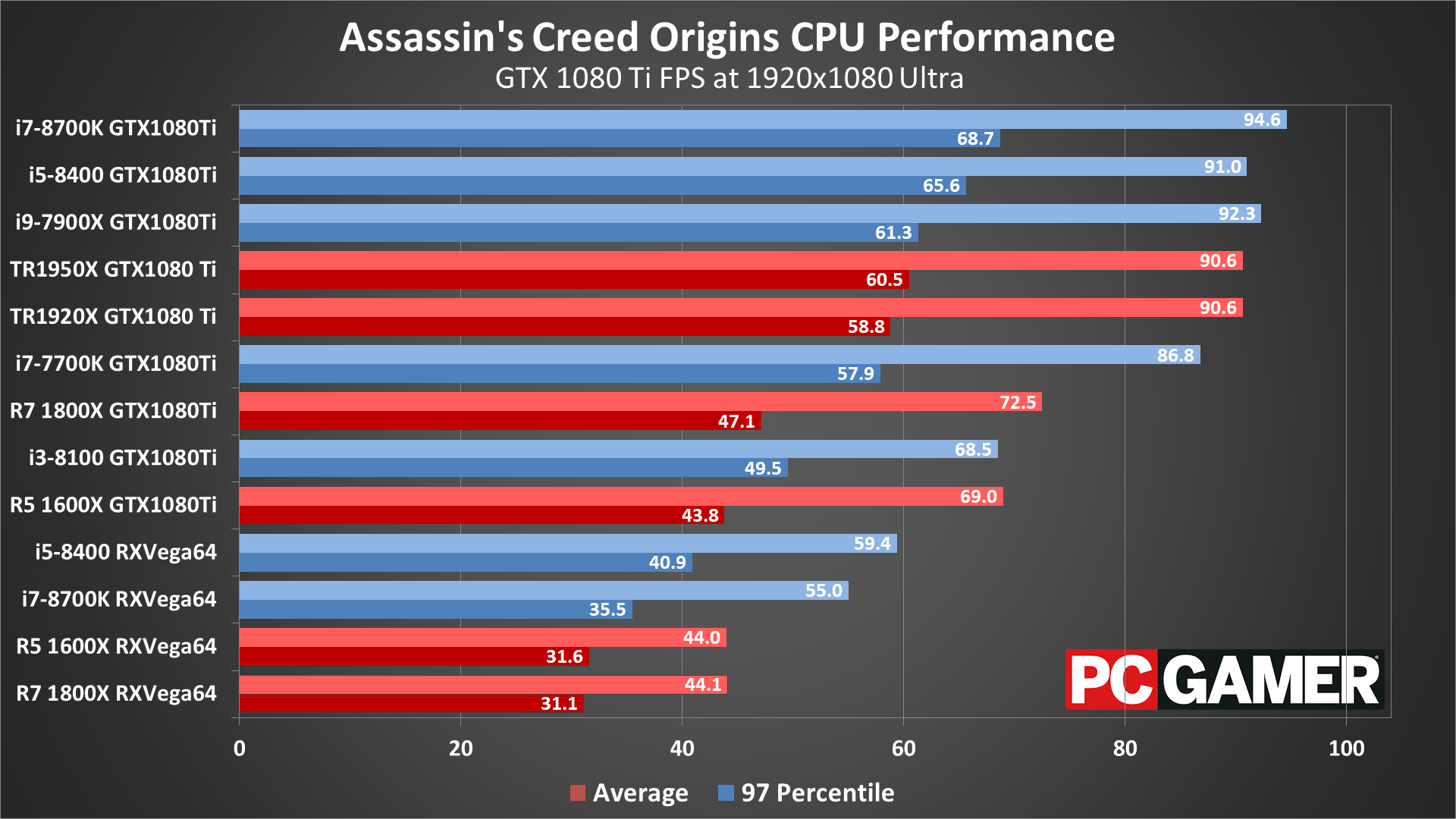
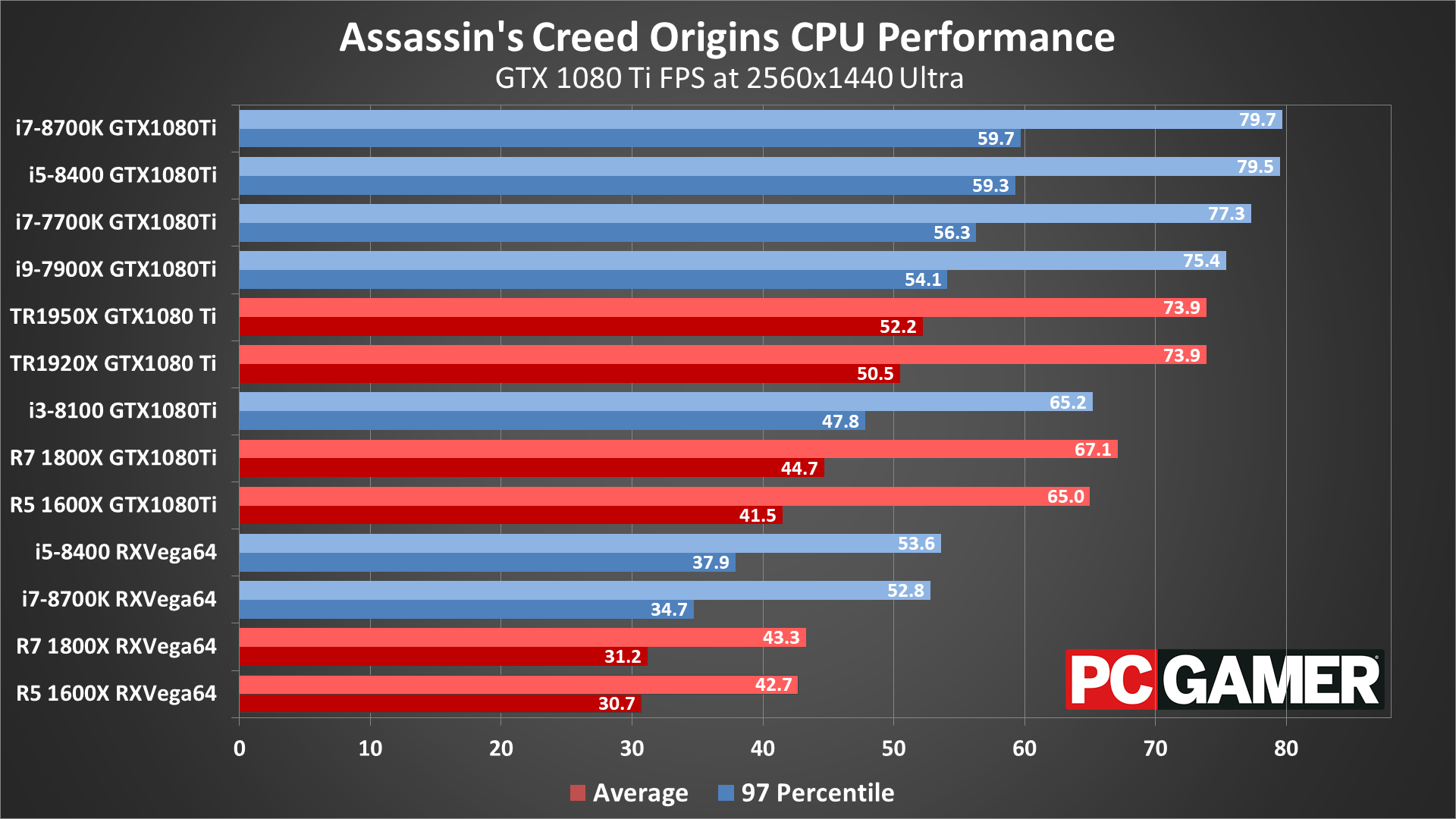
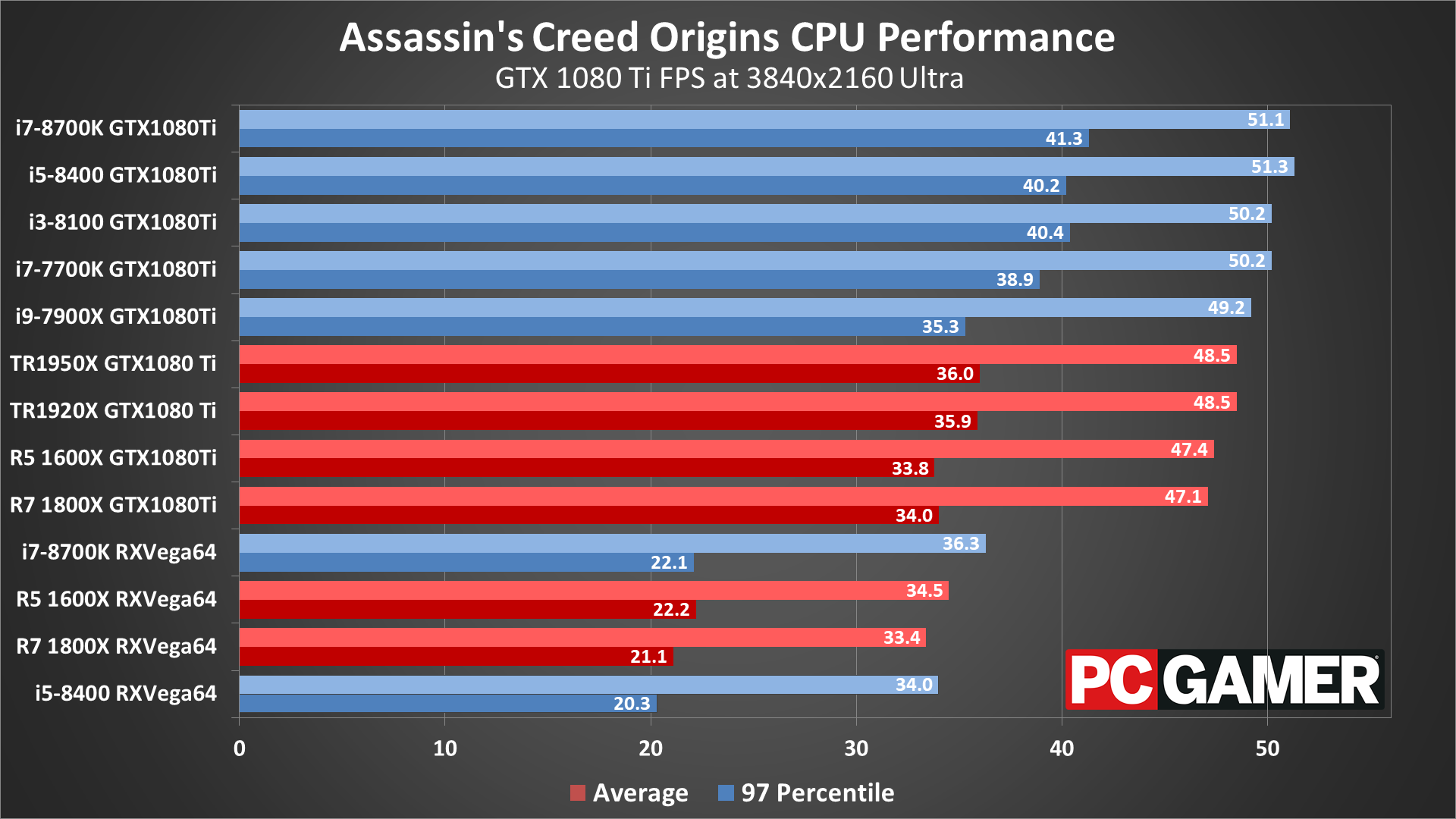
For CPU tests, I've got two different GPUs run on several CPUs. I've included a few options with RX Vega 64 to show how CPU performance limits AMD's faster GPUs. But the primary CPU testing, and what I'll focus on here, is done with the GTX 1080 Ti. For the framerate overlays, I've focused on the primary points of involvement, the i7-8700K, i3-8100, Ryzen vii 1800X, and Ryzen v 1600X, running at 1080p ultra.
The 8700K is the fastest gaming CPU in nearly every game I've tested, which isn't too surprising. Ryzen 7 1800X by comparison falls well short of that mark, though it just edges out the new quad-core i3-8100. Only what'due south really interesting is that Threadripper 1920X and 1950X actually testify substantially improve performance from the AMD processors.
At that place aren't many games that volition scale beyond six-cadre/12-thread, and on Intel CPUs that remains true of Assassin's Creed Origins, but on AMD the Threadripper chips are a solid 25 percent faster than the Ryzen 1800X. It could be that Origins throws around so many threads for AI and physics that Threadripper pulls ahead, or information technology might exist the additional memory bandwidth offered by the platform. Either way, Threadripper owners can at to the lowest degree be happy about gaming performance for a alter. Also note that the 1.03 patch allows the game to run on CPUs with more than than 24 threads, which wasn't possible with the initial release.
Assassin's Creed Origins settings guide
There are fifteen settings that tin can be tweaked that straight affect paradigm quality and help ameliorate operation. There are besides several others that are related but affect performance in other ways—like resolution scaling, adaptive quality, v-sync, and the framerate cap. Individually, virtually of the settings only have a moderate issue on performance, and that's when going from maximum quality to minimum quality. Here are all the major settings, along with the estimate bear upon on performance (measured with a GTX 1070 and Vega 56).
General Settings
Graphic Quality (Very Depression/Low/Medium/High/Very High/Ultra High): a preset that provides a quick way to arrange all the other settings. Very low sets everything to minimum and ultra loftier sets everything to maximum (and requires the HD texture pack). There's nigh a 50 percent improvement in performance going from ultra to very low, and up to a 100 per centum increase on GPUs with less than 3GB VRAM.
Adaptive Quality (Off/thirty FPS/45 FPS/60 FPS): dynamically adjusts anti-aliasing quality to reach the desired framerate if enabled. I examination with this off to ensure identical settings for all tested GPUs.
Anti-Aliasing (Off/Low/Medium/High): attempts to remove jaggies, apparently via SMAA and/or FXAA. Disabling improves performance by well-nigh iv percent.
Shadows (Very Low/Low/Medium/High/Very High/Ultra High): affects the filtering quality and resolution of shadow maps. This is one of the more demanding individual settings, though turning this down still only improves operation by around half dozen per centum.
Surroundings Settings
Environment Details (Very Depression/Low/Medium/High/Very Loftier/Ultra Loftier): adjusts the graphical complication of environmental elements. Going from ultra to very depression but improves performance by i percent in testing.
Texture Detail (Very Low/Depression/Medium/Loftier): the quality of textures used in the game. If you accept enough VRAM, turning this downward merely improves performance past 1-2 percent, though on cards with less than 3GB it can cause a larger change.
Tessellation (Off/Medium/High/Very High): applies displacement maps to enhance the geometry details of surfaces. Turning this off only improves operation by 1-two pct.
Terrain (Medium/High): adjusts the detail of the terrain, and using the lower setting improves performance by four-v percent.
Clutter (Low/Medium/High/Very High): affects the density of various forms of clutter—grass, rocks, and other pocket-size objects. Turning this down improves performance by iii-4 percent.
Fog (Medium/High/Very Loftier): adjusts the fog accuracy, with a relatively negligible bear upon on visuals. Turning this down improves functioning by up to 5 pct.
H2o (Depression/Medium/High/Very High): conform the level of particular of water. Minimum quality just improves functioning past ane-two per centum.
Screen Space Reflections (Off/Medium/High): controls the rendering quality of reflections on wet surfaces. I only saw a 1-2 percent change in performance, though in water scenes it might take a bigger affect.
Volumetric Clouds (Off/On): turns the volumetric clouds on or off, with a pretty sizeable 5 pct change in performance, though the sky looks quite boring with this off.
Characters Settings
Texture Item (Very Low/Low/Medium/Loftier): adjusts texture quality of graphic symbol entities (people and animals) in the world. Turning this downwardly causes negligible i-2 percent improvement in performance.
Character (Very Depression/Low/Medium/Loftier/Very Loftier/Ultra High): level of detail on characters, over again with a small one percent touch on on performance.
Postprocessing Settings
Ambient Apoplexy (Off/High/Very High): a lighting effect that controls the self-shadowing of objects. This is the well-nigh demanding setting in the game, along with shadows, and turning it off improves performance by around six percent.
Depth of Field (Off/On): simulates a camera'southward focus range and blurs out the background. I didn't measure any change in functioning with this setting.
AC Origins is a flake interesting in that the combined impact of the settings appears to be the product of the private settings—meaning, there aren't many 'freebies' that you can leave on with zero change in performance. Of course, nigh of the settings merely cause a minor change in performance, and then at that place's just a express ability to improve performance. AC Origins ends up being enervating at virtually any setting.
In terms of visuals, going from the Very Depression to the Depression preset yields a practiced improvement in image quality with a negligible change in performance (about v percent). Similarly, going from Very High to Ultra but drops performance near three percentage, then I'grand not certain why Ubisoft felt the need to include six presets when ii of them are mostly redundant—nosotros would take been fine with Low/Medium/High/Ultra and but skip the Very Low and Very Loftier alternatives.

Are the organization requirements accurate?
Ubisoft gives the following minimum and recommended organisation requirements:
Minimum
- Os: Windows vii SP1, Windows viii.1, Windows 10 (64-fleck versions only).
- Processor: Intel Cadre i5-2400s @ 2.5 GHz or AMD FX-6350 @ 3.9 GHz or equivalent.
- Video card: NVIDIA GeForce GTX 660 or AMD R9 270 (2048 MB VRAM with Shader Model 5.0 or better).
- Arrangement RAM: 6GB.
- Resolution: 720p.
- Video Preset: Lowest.
Recommended
- OS: Windows 7 SP1, Windows 8.1, Windows 10 (64-bit versions only).
- Processor: Intel Cadre i7- 3770 @ three.5 GHz or AMD FX-8350 @ 4.0 GHz.
- Video carte: NVIDIA GeForce GTX 760 or AMD R9 280X (3GB VRAM with Shader Model 5.0 or improve).
- Organization RAM: 8GB.
- Resolution: 1080p.
- Video Preset: High.
Based on my results from the GTX 770 and R9 380, I'm not sure a GTX 660 or R9 270 will consistently hit 30 fps. For the recommended specs, the GTX 760 is typically around 25 pct slower than the GTX 770, while the R9 280X is about equal to the R9 380 I tested. Those are only pulling effectually forty fps at 1080p medium, so 1080p high is a stretch, merely they should do fine for xxx fps with a few tweaks.
For the CPU side, an i3-8100 is a significant bottleneck on faster GPUs, but only if you're shooting for 60+ fps. If yous're only going for 30 fps, just about whatever decent CPU should suffice. I'd be concerned with older 2-cadre/4-thread Cadre i3 parts, but they should all the same be able to get thirty fps.
My personal recommendation for Ac Origins would be at least a GTX 1060 6GB. Until and unless the performance improves on AMD hardware, it'south going to be less desirable in Ac Origins. For 1440p gaming, the GTX 1070 Ti and the existing 1070 and 1080 cards will be your weapons of choice, assuming y'all can't manage to splurge on the 1080 Ti. And for your CPU, 6-core processors like the i5-8400 aid if you have a top-shelf GPU, but yous can still go decent framerates from a 4-core/4-thread CPU like the i3-8100 or the previous generation i5-7400.
What about this DRM business?
There have likewise been reports circulated about DRM causing the high CPU utilization, based on statements fabricated past the cracker/pirate Voksi. Ubisoft denies those claims, and without an actual cracked version information technology'southward impossible to say one way or the other. AC Origins has not nonetheless been croaky after more than two weeks, then the VMProtect + Denuvo approach is succeeding in that respect. Simply Voksi has offered 'proof' that DRM calls are made during grapheme motility, which causes a heavy CPU load.
Over again, it's impossible to measure the actual performance impact without a working crack, merely what I've seen is that CPU utilization jumps way upward in the cities, particularly if y'all're using a fast GPU. CPU utilization also drops essentially if you lot're using a slower GPU.
In other words, calculating all the AI, physics, graphics, etc. consumes a lot of CPU time. It's not graphic symbol movement merely rather framerate and location that largely determines CPU load. Out in the desert, framerates are substantially higher, and CPU utilization is lower, which once again indicates that it is in fact AI and graphics calculations causing the CPU spikes and not some unrelated DRM calculations.
If you wait at the CPU performance results in a higher place, clearly quad-core processors can exist fully utilized in Air conditioning Origins. I saw consistent 100 percent CPU load on 4-core/4-thread and 4-cadre/8-thread CPUs, and even the 6-core/half dozen-thread i5-8400 is close to 100 pct load in the cities.
Running at 100 pct CPU utilization isn't inherently bad—it used to be that all games would peg your CPU at 100 percent, back before nosotros had quad-core and college CPUs. Information technology simply means doing other stuff (livestreaming, or watching Twitch on a secondary display) will need more than cores/threads than y'all're used to. It also means y'all might see occasional dips in performance if a background task kicks off. If yous desire a consistent 60+ fps in AC Origins, yous'll desire a fast graphics card and a fast CPU.
Source: https://www.pcgamer.com/assassins-creed-origins-performance-guide/
0 Response to "what type of graphics card to play assasins creed origins on ultra high settings"
Post a Comment